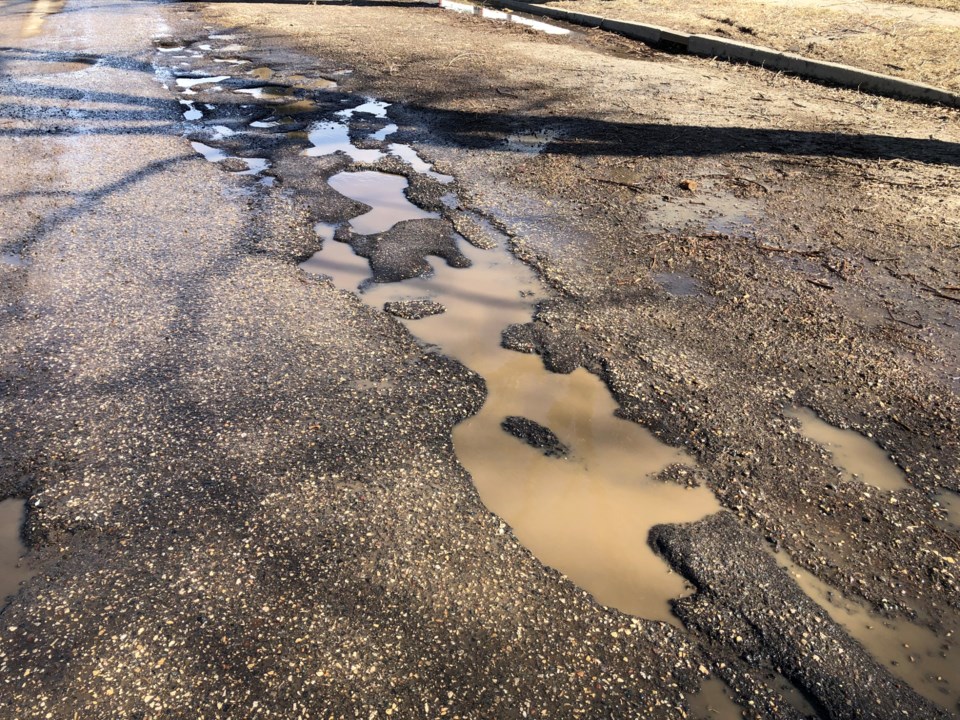CAA Saskatchewan’s 2023 Worst Roads Campaign is over and Coteau Street West finished in third place, although it briefly flirted with second place a day before the competition closed.
From April 4 to 25, Saskatchewan road users — including pedestrians, motorists, cyclists, transit riders, and motorcyclists — nominated and voted for their worst, most unsafe roads. The common concerns were crumbling pavement, potholes, lack of maintenance or repair, congestion, insufficient signage, and poor infrastructure.
CAA Saskatchewan announced the top 10 roads on April 26, with this year’s “winners” including:
- Highway 44 near Eston due to potholes
- Highway 30 near Eston because of potholes
- Coteau Street West due to potholes
- Highway 13 near Redvers because of potholes
- Highway 5 near Buchanan due to poor road maintenance
- Butte Street in Pilot Butte because of potholes
- Highway 9 near Whitewood due to potholes
- Highway 123 near Petaigan/Ravendale/Pemmican Portage because of potholes
- Highway 9 near Hudson Bay due to potholes
- Old Highway 35 near White Fox because of potholes
A total of 292 roads were nominated and voted on during this year’s campaign. These included roads and highways that have made CAA’s Worst Roads Top 10 list in previous years, such as Highway 47 near Springside (No. 2 last year and No. 2 in 2018), Ninth Avenue Southwest in Moose Jaw (No. 10 last year and in 2018), and new additions including Regina’s Connaught Street, Weyburn’s First Avenue Northeast, and Wanuskewin Road in Saskatoon.
The collection of roads nominated and voted this year indicates that road users are concerned about their safety while travelling on roads and highways, which this year’s top 10 list shows.
During a media scrum on April 25, city manager Jim Puffalt said the issues plaguing Coteau Street West are partly due to deteriorating underground infrastructure that needs to be replaced.
“We never want to be on the top 10 list at all. The last time we were was High Street. That was my first week here (in May 2018) and we had to do something about that,” he said.
Ninth Avenue Southwest was also an issue in recent years, but the Ministry of Highways was — and is — responsible for fixing that issue because of slumping issues, Puffalt continued. Meanwhile, the city has repaired 60 kilometres of roads during the last seven years in conjunction with replacing cast iron pipes.
“That’s the best maintenance system in the world. As you know, we’ve really established a turnkey process. We don’t want to spend a million dollars repaving a road and then having to go dig it up because the undergrounds are bad,” he said, although that sometimes must happen.
City hall is aware of the issues affecting Coteau Street West and will patch it with hot mix asphalt when the weather improves, Puffalt added. The municipality attempted to temporarily address the potholes with cold mix, but the recent snowstorm washed away the material.
Weather conditions, age of the roads, heavy traffic, and lack of maintenance cause road deterioration, while in cold climates like Saskatchewan, the freeze-thaw cycle plays a key role in creating potholes — a problem that occurs when temperatures regularly go above and below the freezing point, CAA Saskatchewan said.
When rain or snow seeps through cracks and openings in the pavement, it freezes and expands, causing the pavement to heave upward. As temperatures rise, the ground underneath returns to its normal level, leaving a cavity or hole that breaks apart with continued traffic use over the fractured pavement.
Saskatchewan has almost 250,000 km of roads, the highest length of road surface compared to any other province in Canada, the business added. These roads, often a lifeline for residents, are used regularly for business and leisure road travel, and when these roads are allowed to deteriorate, road users pay the price.




